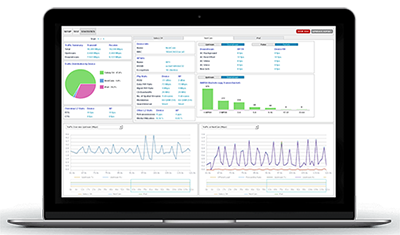Design & Testing for IoT-Enabled Smart Appliances Gets Easier with Ixia, K2 Partnership
Ixia and K2 Inc. are working together to speed and simplify design and production of IoT-enabled smart appliances. Under the partnership, the companies will integrate Ixia IoT's test and assessment solution with the K2 Software-Defined IoT Platform to improve WiFi testing for these devices.
by Vance McCarthy
Tags: smart appliances, devices, interoperability, IoT, Ixia, lifecycle, K2, performance, test, WiFi,

vp business development

"Working together, Ixia and K2 will provide a more comprehensive testbed that can look deeper at some of the more vexing challenges with WiFi-enabled devices."
Ixia and K2 Inc. are working together to speed and simplify design and production of IoT-enabled smart appliances. Under the partnership, the companies will integrate the Ixia IoT's test and assessment solution with the K2 Software-Defined IoT Platform to improve WiFi testing for these devices.
The partnership comes as recent research suggests the ‘smart appliance’ market is poised to be a lucrative IoT market segment. One estimate from Markets and Markets predicts it will top $37 billion by 2020.
With so much opportunity, home appliance vendors are scrambling to bring solutions for smart appliances, device maintenance and diagnostics to market. That said, appliance vendors are finding that delivering low-cost and reliable Wi-Fi-based connectivity for products is proving to be troublesome, Ixia and K2 execs told IDN.
Current approaches are too complex, mostly due to a lack of visibility and high-quality testing tools, according to Ixia’s vice president of business development Scott Westlake “By integrating Ixia and K2, we’re enabling OEMs using the K2 platform to easily conduct their own rigorous testing throughout the product development cycle,” he said.
K2 CEO’s Andy Chinmulgund noted that with the Ixia and K2 IoT solutions working together, device makers and OEMs will be able to automate testing, deliver more accurate test results and better visibility. Users will also be able to test their WiFi-enabled smart appliances much early in the development cycle, he added.
“This enables them to design-in performance and quality early in the cycle, rather than having to patch together solutions late in the process, which is time-consuming and problematic,” Chinmulgund explained. “Gaining greater control of the performance of their devices in the real world will help to expand IoT into many use cases where performance is currently delaying or preventing deployment.”
Westlake also described how the Ixia / K2 approach solves many of the unique challenges of designing and manufacturing ‘smart appliances’ – particularly adding WiFi-enablement to a regular appliance or consumer electronics device.
“Unlike manufacturers of typical consumer electronic devices, appliance manufacturers have certain specific requirements such as hidden line of sight, temperature variations, and longevity of product,” he said. “The Ixia / K2’s integration will help appliance manufacturers to seamlessly qualify different wireless connectivity solutions,” Westlake added.
Making WiFi-Enabled Smart Appliances Reliable in the Real World

This need to test for so many variables highlights another advantage the Ixia/K2 partnership – an ability to provide WiFi testing results that are accurate out in real-world environments -- – not just in the lab. “Failures in the field are expensive and unfortunately common, and damage the reputation of device vendors. The smart appliances evolution is still in its infancy and products have to be tested and optimized in a complex set of real-world conditions before they can perform reliably in the field. It’s not a simple challenge,” Westlake added.
“Working together, Ixia / K2 provide a more comprehensive testbed that can look deeper at some of the more vexing challenges with WiFi-enabled devices,” Westlake noted, including:
- WiFi device performance which today is often not strong or reliable enough to meet many IoT use cases, especially for healthcare and industrial systems.
- Interoperability and performance testing needs to be rigorous and accurate. This can include testing for interference and testing at longer ranges. Today these tests can be time-consuming, difficult and are often error-prone.
- Without accurate and detailed testing results, designing an efficient and reliable WiFi IoT device is often costly and very complex.
Add up all these challenges, and it’s easy to see why smart appliance makers are often forced to over-design their products to build in a margin of safety so their products will operate.
“This increases unit costs and reduces ROI,” Chinmulgund said, “and can even limit ‘smart’ capabilities to only the higher-end of any product line.” With more accurate and automated testing available, OEMs will be able to avoid such costly over-design work, he added, making smart appliances more affordable to make -- and available at lower price points to consumers.
“The Ixia / K2 integrated solution will simulate a wide range of Wi-Fi networks and deployment conditions in an integrated testbed,” Westlake said. The result: OEMs receive detailed performance analytics, as well as insights into failures. This data will help vendors and OEM partners more easily identify potential performance issues, propose fixes, and then quickly evaluate their final (or revised) products before mass production and deployment, he said.
In specific, this Ixia / K2 integrated approach lets ‘smart appliance’ makers:
- Systematically simulate both real-world WiFi access points, as well as the challenging environments they operate in (such as overlapping WiFi signals, interference and distance).
- Ensure proper implementation of best practice security protocols through a battery of security tests to validate all valid combinations of authentication and encryption configurations work as expected.
“The approach is similar [to mobile app test environments] in the sense that these platforms are enabling systematic testing of apps against a broad range of both real and simulated mobile device hardware and operating systems,” Chinmulgund said. That said, the Ixia/K2 solution “combines the ability to test with both real access points and a wide range of simulated ‘worst-case’ access points and environmental conditions, enabling the rigorous, systematic and dependable testing that’s needed to enable reliable mission-critical IoT applications,” he added.
While the Ixia / K2 collaboration is at present focused on testing ‘last mile’ WiFi connections for smart appliance, execs from both firms told IDN they are exploring further ways to collaborate for testing in other big IoT solutions – particularly for service providers and enterprise IT.
More Ixia, K2 IoT Collaboration Likely On the Way
“We anticipate additional areas of collaboration. . . both for continuous testing of the ‘end-to-end network’ as well as for testing many of the individual components in those networks,” Westlake said. Over the long term he also expects the Ixia / K2 partnership will let smart appliance makers “substantially increase performance and reliability in industrial or medical use-cases, where high performance and reliability, rather than cost, are absolutely critical.”
Chinmulgund added “Highly-reliable WiFi enables many new use-cases.” For example, he noted in retail WiFi IoT is enabling a wide array of applications, from point-of-sale systems to robotic warehouse management. “WiFi failure can have a huge impact on operations, directly impacting revenue,” he said.
Related:
- InfluxData's Latest Updates Optimize Time Series Data for Better Performance, Scale and Management
- Actian Zen 16.0 Update Simplifies Delivery and Boosts Performance of Edge, IoT Apps
- Virtana Infrastructure Performance Management Adds AI-driven Capacity Planning
- e2open’s Supply Chain SaaS Updates Help Firms Reduce Operational Risks with Deeper Visibility
- Report: Endor Labs Identifies 2023 Operational, Security Risks To Open Source
All rights reserved © 2025 Enterprise Integration News, Inc.



